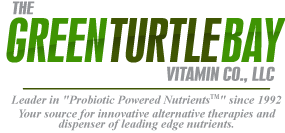Dietary iron may increase risk of chronic disease in elderly
|
27/11/02 - A new study shows that several dietary factors are associated with a risk for high iron stores in the elderly, linked in recent research to a higher risk of chronic diseases, especially cardiovascular disease. (editor’s note: The Green Turtle Bay Vitamin Company’s products do not include iron!) Researchers set out to evaluate the extent to which dietary factors contribute to high iron stores, using data collected in the Framingham Heart Study. Those who ate more meat or took supplements were more likely to have high iron stores. The 246 men and 368 women in the sample averaged 75 years old and had a medium serum ferritin concentration; men had significantly higher serum ferritin values than women. The subjects’ usual dietary intakes were measured using a food-frequency questionnaire. Not unexpectedly, among subjects who took supplemental iron the risk of high iron stores was as much as four times that of subjects who did not take supplements. Those who ate more than four servings of red meat a week had a three-fold likelihood of high iron stores, whereas, poultry and seafood were unrelated to risk. The 30 per cent of participants who consumed more than three servings of fruit or fruit juice daily had a significantly higher risk of high iron stores, which the authors propose may be due to the enhancement of iron bioavailability from vitamin C and other organic acids in fruit. Whole grains, when eaten more than seven times weekly, substantially lowered the risk of high iron stores in comparison to refined grains. According to the authors, elderly persons who consume a typical Western diet high in red meat or who take unprescribed iron supplements may be increasing their risk of acquiring high iron stores and, thus, their risk of developing chronic disease. Source: American Journal of Clinical Nutrition 2002;76:1375-84 |
| Iron overdose may impact heart health
25/11/02 - An increasing number of people in modern industrialized societies are iron replete, rather than iron deficient, and iron overload has been implicated as a possible source of increased cardiovascular disease (CVD) risk, report researchers in the new issue of the American Journal of Clinical Nutrition. (editor’s note: The Green Turtle Bay Vitamin Company’s products do not include iron!) Researchers examined data on reproductive age women from the third US National Health and Nutrition Examination Survey (NHANES III), including the relationship between race-ethnicity, iron status, and CVD risk factors. The participants included 1,178 white, 1,093 African-American, and 1,075 Mexican-American women aged 20 to 49 years who were subdivided into low, medium, or high iron status categories according to their serum ferritin concentrations, a measure of iron stores in the body. Within each racial group, most indicators of CVD risk increased with serum ferritin status. For example, triacylglycerol and total cholesterol concentrations were higher, and HDL cholesterol concentrations were lower among subjects with the highest serum ferritin values. Mexican-American women had significantly higher concentrations of triacylglycerols and glucose and lower HDL concentrations than whites and African-Americans, even though their iron stores were lower than the other two racial groups. The study authors suggested that future studies should address issues of racial differences in response to iron repletion and/or iron deficiency as risk factors for chronic disease. Source: American Journal of Clinical Nutrition 2002;76:1256-60
|




